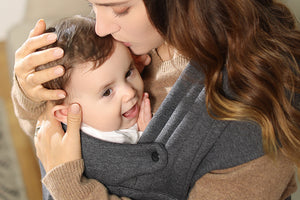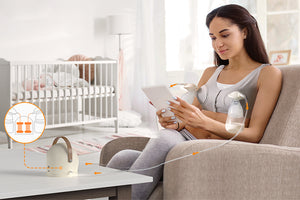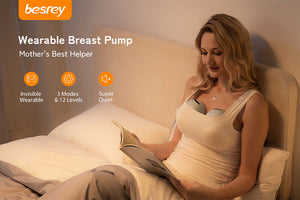One of the benefits of a bedside crib is that it promotes the recommendation of parent and baby having separate sleeping spaces while keeping the baby within arm's reach so that care can be easily given to the baby when needed. Used correctly and with relevant professional advice, cribs can help reduce the risk of sudden infant death syndrome (SIDS)

When Should a Baby Sleep in a Bedside Crib?
A bedside sleeper crib is generally a bit larger than a bassinet, and they also allow you to keep your baby at your bedside, giving you the comfort that your baby is nearby.
Cribs offer the ultimate convenience of being able to tend to them when they need you while giving you and your baby your own sleeping spaces.
Co-sleepers are usually on lockable casters, which make moving them around a room, or to other rooms easier than cribs or bassinets, which often need to be lifted.
They are also fairly versatile as they can be used independently and placed anywhere when not used in the co-sleeping setup. In addition, there is often storage space underneath for you to keep all the sleeping essentials on hand.

Why Won't My Baby Sleep in a Bedside Crib?
There could be many reasons your baby won't sleep in a crib, and it's always important to remember that all babies are different and that what is considered 'normal' regarding a baby's sleep habits or requirements is very wide-ranging.
Much will depend on the stage of development your baby is at. For example, more difficulties may be faced getting a newborn to sleep in a crib than an older baby. This is why many parents choose to use a bassinet for the first few months.
It's vital from early on that your baby begins to understand that night is not day and day is not night. In the daytime, keep your home bright with curtains open; at night, keep the lights low or not on.
Newborns have no concept of being afraid in the dark—after all, they spent 9 months in complete darkness in the womb.
Tips for Getting Your Baby to Sleep in a Bedside Crib
Here are some tips the Mayo Clinic recommends for encouraging good sleep habits in your baby.
- Follow a Consistent, Calming Bedtime Routine
Over-stimulation in the evening can make it difficult for your baby to settle to sleep. Try bathing, cuddling, singing, playing quiet music or reading, with a clearly defined endpoint when you leave the room. Begin these activities before your baby is overtired in a quiet, softly lit room.
- Put Your Baby to Bed Drowsy but Awake
This will help your baby associate bed with the process of falling asleep. Remember to place your baby sleeping on their back and clear the crib or bassinet of blankets and other soft items.
- Give Your Baby Time to Settle Down
Your baby might fuss or cry before finding a comfortable position and falling asleep. If the crying doesn't stop, check on your baby, offer comforting words and leave the room. Your reassuring presence might be all your baby needs to fall asleep.
- Consider a Pacifier
A pacifier might do the trick if your baby has trouble settling down. Research suggests that using a pacifier during sleep helps reduce the risk of SIDS.
- Keep Nighttime Care Low-key
When your baby needs care or feeding during the night, use dim lights, a soft voice and calm movements. This will tell your baby it's time to sleep — not play.
- Respect Your Baby's Preferences
If your baby is a night owl or an early bird, you might want to adjust routines and schedules based on these natural patterns.
The ability to get your baby to sleep soundly through the night or not isn't a measure of your parenting skills. Nor should you compare your baby's sleep habits with other babies.
Following the advice of experts and making an effort to understand your baby will undoubtedly go a long way to helping you reclaim some well-earned rest for yourself. Talk to your doctor if you have any serious concerns about your baby's sleep.
When to Stop Using a Bedside Crib?
Various factors will influence when you can transition your child to a bed. It will vary from toddler to toddler, but it has much to do with their mental development.
Children under 3 years may find the concept of 'staying in bed' difficult, so the right time to transition a child from a crib to a real bed will depend on their maturity rather than their actual age.
Also, a child may be 'attached' to their crib and its security and may be reluctant to sleep in a bed. Again, this has a lot to do with their mental maturity.
Transitioning a toddler under 3 years to a regular mattress is not usually recommended.
Introducing the Besrey Bedside Crib for Your Baby
At Besrey, we are no strangers to babies' sleep needs, and designing and manufacturing infant sleeping products have been our area of expertise for many years.
The Besrey Bedside Sleeper Crib is the perfect way to keep your little one close and safe, with minimal nighttime nursing and feeding disruption.
This premium bedside sleeper is fully compliant with ASTM, CPSIA, and CCPSA safety standards, and all materials are 100% safe and non-toxic.
- Some of the features of the Besrey Bedside Sleeper include:
- 3D vertical upright cotton mattress to protect baby's spine
- Premium woven cotton soft-touch fabric which exceeds ASTM standards
- Light smooth-lined soft padding and breathable mesh
- Zip-up mosquito net and shade canopy
- 9 adjustable height levels
- Securing straps and anchor plate
- Ample underneath storage for baby essentials
Click here to take a more in-depth look at this fantastic offering.

Why is the Besrey Bedside Sleeper Safe for Your Newborn?
- Fully compliant with ASTM, CPSIA, and CCPSA safety standards
- All sourced materials are checked and tested to ensure they are 100% safe and non-toxic
- Extendable horizontal feet make it nearly impossible to tip over
- Crib guardrail to prevent falls
In addition to the above points, the Besrey Bedside Sleeper also features 360° swivel casters with brakes that make it easy to reposition or move from room to room.
At the same time, spacious underneath storage allows you to keep all your baby's sleeping essentials nearby. Furthermore, no tools are required for assembly, and the fabric is removable and washable.
Where Can You Buy the Besrey Bedside Sleeper?
The Besrey Bedside Sleeper is available to buy now directly from Besrey.



